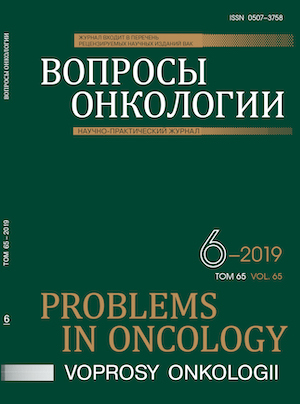Аннотация
В свете активно появляющихся новых данных о взаимосвязи между нарушениями циркадианных ритмов в организме и развитии злокачественных новообразований, авторы провели экспериментальное исследование с целью установить наличие/отсутствие изменений в ритмичности экспрессии часовых генов в опухоли по сравнению с нормальными тканями, а также изучить, влияет ли опухоль на циркадианные ритмы интактных тканей в организме-опухоленосителе. Исследование выполнено на 75 крысах-самках Вистар, была использована перевиваемая внутрибрюшинно опухоль яичников. получены данные о фрагментации суточного ритма локомоторной активности у крыс с опухолью яичника по сравнению с животными без опухоли. Выявлено, что ритм пролиферации в клетках опухоли отсутствует, а также установлено нарушение ритма пролиферации неопухолевых клеток (на примере клеток кишечного эпителия) у крыс-опухоленосителей, тогда как у интактных крыс наблюдалась четкая ритмичность пролиферации аналогичных нормальных клеток. Среднесуточный уровень экспрессии часовых генов (BMAL1, CLOCK, CRY1, PER2) был существенно снижен в опухоли по сравнению с нормальной тканью. На основании полученных данных были выбраны 2 временные точки для проведения химиотерапии в последующих экспериментах in vivo, запланированных для изучения эффектов хронохимиотерапии.
Библиографические ссылки
Honma S, Ono D, Suzuki X Inagaki N, Yoshikawa T, Nakamura W, Honma K. 2012. Suprachiasmatic nucleus. In: Prog Brain Res. 2012;199:129-141.
Partch CL, Green CB, Takahashi JS. Molecular architecture of the mammalian circadian clock. Trends Cell Biol. 2014;24:90-9.
Shostak A. 2017. Circadian Clock, Cell Division, and Cancer: From Molecules to Organism. Int J Mol Sci. 2017; 18(4).
IARC Working Group on the Evaluation of Carcinogenic Risks to Humans. 2010. Painting, firefighting, and shiftwork. IARC Monogr Eval Carcinog risks to humans. 2010;98:9-764.
Filipski E, Delaunay F, King VM, Wu M-W, Claustrat B, Gréchez-Cassiau A, Guettier C, Hastings MH, Francis L. Effects of Chronic Jet Lag on Tumor Progression in Mice. Cancer Res. 2004;64:7879-7885.
Anisimov VN, Vinogradova IA, Panchenko AV, Popovich IG, Zabezhinski MA. Light-at-night-induced circadian disruption, cancer and aging. Curr Aging Sci. 2012;5:170-7.
Lamia KA. Ticking time bombs: connections between circadian clocks and cancer. F1000Research. 2018;6:1910.
Shilts J, Chen G, Hughey JJ. Evidence for widespread dysregulation of circadian clock progression in human cancer. PeerJ. 2018;6:e4327. Available from: http://www. ncbi.nlm.nih.gov/pubmed/29404219
Ye Y Xiang Y Ozguc FM, Kim Y Liu C-J, Park PK, Hu Q, Diao L, Lou X Lin C, et al. The Genomic Landscape and Pharmacogenomic Interactions of Clock Genes in Cancer Chronotherapy. Cell Sys. 2018; 6:314-328.e2.
Cadenas C, van de Sandt L, Edlund K, Lohr M, Hellwig B, Marchan R, Schmidt M, Rahnenführer J, Oster H, Hengstler JG. Loss of circadian clock gene expression is associated with tumor progression in breast cancer. Cell Cycle. 2014;13:3282-3291.
Sotak M, Polidarova L, Ergang P, Sumova A, Pacha J. An association between clock genes and clock-controlled cell cycle genes in murine colorectal tumors. Int J Cancer. 2013;132:1032-1041.
de Assis L, Moraes M, Magalhaes-Marques K, Kinker G, da Silveira Cruz-Machado S, de Lauro Castrucci A. Non-Metastatic Cutaneous Melanoma Induces Chronodisruption in Central and Peripheral Circadian Clocks. Int J Mol Sci 2018;19:1065.
Yang K, Ye H, Tan X-M, Fu X-J, Li H-X. 2015. Daily rhythm variations of the clock gene PER1 and cancer-related genes during various stages of carcinogenesis in a golden hamster model of buccal mucosa carcinoma. Onco Targets Ther. 2015;13:1419.
Tan X-M, Ye H, Yang K, Chen D, Wang Q-Q, Tang H, Zhao N-B. Circadian variations of clock gene Per2 and cell cycle genes in different stages of carcinogenesis in golden hamster buccal mucosa. Sci Rep. 2015;5:9997.
Bespalov VG, Kireeva GS, Belyaeva OA, Kalinin OE, Senchik KX Stukov AN, Gafton GI, Guseynov KD, Belyaev AM Both heat and new chemotherapeutic drug dioxadet in hyperthermic intraperitoneal chemoperfusion improved survival in rat ovarian cancer model. J Surg Oncol. 2015;113:438-442
Киреева Г.С., Беляева О.А., Сенчик К.Ю., Беспалов В.Г., Стуков А.Н., Губарева Е.А., Майдин М.А. Асцитная опухоль яичников у крыс - адекватная доклиническая модель канцероматоза для изучения интраперитонеального химиоперфузионного лечения. Сибирский онкологический журнал. 2019;18(1):71-78
Metz RP, Qu X, Laffin B, Earnest D, Porter WW. Circadian clock and cell cycle gene expression in mouse mammary epithelial cells and in the developing mouse mammary gland. Dev Dyn. 2006; 235:263-71.
Karman BN, Tischkau SA. Circadian Clock Gene Expression in the Ovary: Effects of Luteinizing Hormone1. Biol Reprod. 2006;75:624-632.
Sotak M, Polidarova L, Ergang P, Sumova A, Pacha J. An association between clock genes and clock-controlled cell cycle genes in murine colorectal tumors. Int J cancer. 2013; 132:1032-41.
Altman BJ, Hsieh AL, Sengupta A, Krishnanaiah SX Stine ZE, Walton ZE, Gouw AM, Venkataraman A, Li B, Goraksha-Hicks P, et al. MYC Disrupts the Circadian Clock and Metabolism in Cancer Cells. Cell Metab. 2015; 22:1009.
Huisman SA, Oklejewicz M, Ahmadi AR, Tamanini F, Ijzermans JNM, van der Horst GTJ, de Bruin RWF. Colorectal liver metastases with a disrupted circadian rhythm phase shift the peripheral clock in liver and kidney. Int J Cancer;136:1024-1032.
Al-Dewachi HS, Wright NA, Appleton DR, Watson AJ. Studies on the mechanism of diurnal variation of proliferative indices in the small bowel mucosa of the rat. Cell Tissue Kinet. 1976;9:459-67.
Camplejohn RS, Nias AH. A study of diurnal proliferative activity in tumour and small intestine of C3H mice bearing a transplanted mammary carcinoma. Virchows Arch B Cell Pathol Incl Mol Pathol. 1983;44:163-71.
Balakrishnan A, Stearns AT, Park PJ, Dreyfuss JM, Ashley SW, Rhoads DB, Tavakkolizadeh A. MicroRNA mir-16 is anti-proliferative in enterocytes and exhibits diurnal rhythmicity in intestinal crypts. Exp Cell Res. 2010; 316:3512-21.
Hojo H, Enya S, Arai M, Suzuki X Nojiri T, Kangawa K, Koyama S, Kawaoka S. 2017. Remote reprogramming of hepatic circadian transcriptome by breast cancer. Oncotarget. 2017;8:34128-34140.
Redon CE, Dickey JS, Nakamura AJ, Kareva IG, Naf D, Nowsheen S, Kryston TB, Bonner WM, Georgakilas AG, Sedelnikova OA. Tumors induce complex DNA damage in distant proliferative tissues in vivo. Proc Natl Acad Sci U S A. 2010;107:17992-7.

Это произведение доступно по лицензии Creative Commons «Attribution-NonCommercial-NoDerivatives» («Атрибуция — Некоммерческое использование — Без производных произведений») 4.0 Всемирная.
© АННМО «Вопросы онкологии», Copyright (c) 2019
